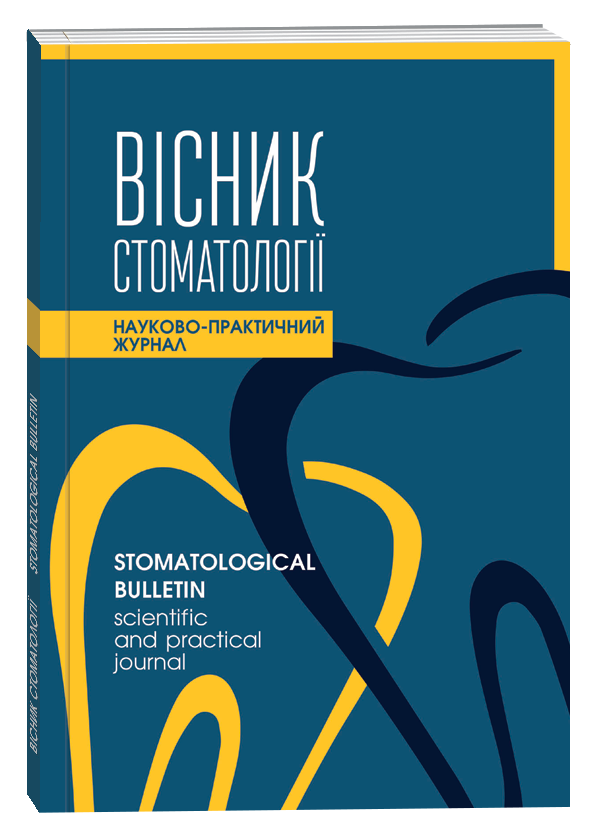THE MODIFICATON OF M.S. BUGAYOVA AND S.A. NIKITIN’S DIET (1954) FOR MODELING OF DENTAL CARIES IN RATS
DOI:
https://doi.org/10.35220/2078-8916-2023-47-1.12Keywords:
cariogenic diet, Stefan's diet, Bugayova and Nikitin's diet, modification of cariogenic diet, rats.Abstract
The use of Stefan's diet for modeling caries in rats may not be effective due to the probable presence of substances (preservatives) that inhibit the action of cariogenic microbiota in dry milk as one of the components of the diet. Bugayova and Nikitin's alternative diet, which contains cottage cheese instead of dry milk (18,5 %), sugar (54 %), white bread croutons (18,5 %), vegetable oil (5 %), salt (4 %) and «Undevit» (1 dragee on 100 g of feed), causes significant growth retardation in rats and can cause death in rats weighing less than 45 g during 3 weeks. Purpose of the study was to modify the ratio of the components of Bugaiova and Nikitin’s diet in order to improve the feed consumption of rats and prevent the delay in body weight growth for the formation of reliable indicators of dental caries. Research methods. Observations were carried out on 1-month-old Wistar rats with an initial body weight of 46 to 58 g, which were divided into three groups of 10 animals in each group: 1 – standard complete diet, 2 – Bugaiova and Nikitin’s cariogenic diet of, 3 –Bugayova and Nikitin’s modified diet. The duration of the experiment is 50 days. Animals were weighed weekly. The jaws with teeth were isolated from the rats and the number and depth of carious cavities were counted at the end of the experiment. Scientific novelty. Reducing the content of table salt by 4 times and "Undevit" by 2 times with the compensation of total weight due to the increase in the content of refined sugar to 57% in Bugaiova and Nikitin’s modified diet contributes to the improvement of feed consumption by rats and to the growth of their body weight, does not cause death of rats. Conclusions. The cariogenic diet in the given modification helps to optimize the growth of the rat body weight and the formation of reliable indicators of dental caries within 50-60 days.
References
Зайцев А.В., Выженко Е.Е., Николишин А.К., Ваценко А.В., Гриценко Ю.Ю. К вопросу о биомоделировании кариеса зубов. Вісник ВДНЗУ «Українська медична стоматологічна академія». 2014. т.14. вип. 1(45). С. 124–126.
Larson R.H., Theilade E., Fitzgerald R.J. The interaction of diet and microflora in experimental carries in the rat. Archs Oral Biol. 1967. V. 12. P. 663–668.
Stephan R.M. The development of caries on the buccal and lingual tooth surfaces of rats as well as proximal and fissure carries. J. dent. Res. 1951. V. 30. P. 484–491.
Stephan R.M. Effects of different types of human foods on dental health in experimental animals. J. Dent. Res. 1966. 45. P. 1551–1561. 5. Терешина Т.П., Косенко К.М, Левицький А.П., Мозгова Н.В., Близнюк Г.О. Експериментальне вивчення дії та специфічної ефективності засобів для догляду за порожниною рота: Метод. рекомендації. Київ: ДФЦ МОЗ України, 2003. – 42 с.
Гончарук С.В., Скидан М.И., Волкова О.С. Сравнительная кариес-профилактическая эффективность кверцетина, кальцикора и лецитина-2. Вісник стоматології. Спеціальний випуск. 2010. № 5. С. 5–9.
Деньга А.Э., Деньга О.В., Мозговая Н.В., Тищенко Т.Л. Кариеспрофилактическое действие зубного эликсира «Гранатовый». Вісник стоматології. Спеціальний випуск. 2010. № 5. С. 14–17.
Gelmboldt V.O., Lytvynchuk I.V., Shyshkin I.O., Khromagina L.M., Fonari M.S., Kravtsov V. C. Bis(2‐,3‐,4‐ carboxyethylpyridinium)hexa-fluorosilicates as potential caries prophylactic agents. Arch. Pharm. DPhG. 2022. 8 March. e2200074: doi.org/10.1002/ ardp.202200074.
Milgrom P., Riedy C.A., Weinstein P., Tanner A.C.R., Manibusan L., Brucs J. Dental caries and its relationship to bacterial infection, hypoplasia, diet, and oral hygiene in 6- to 36-month-old children. Community Dent. Oral. Epidemiol. 2000. 28. P. 295–306.
Touger-Decker R., van Loveren C. Sugars and dental caries. Am. J. Clin. Nutr. 2003. 78. P. 88S–92S.
Никитин С.А., Бугаёва М.Г. Экспериментальный кариес у белых крыс. Стоматология. 1954. № 1. С. 9–17.
Бугаёва М.Г. Влияние питания белых крыс (самок) диетами, богатыми углеводами на развитие кариеса зубов у потомства. Проблемы терапевтической стоматологии. 1970. № 5. С. 11–16.
Волкова О.С., Рябоконь Е.Н. Электронно- микроскопические изменения в пульпе крыс, содержащихся на кариесогенном рационе с добавлением лецитина. Медицина сьогодні і завтра. 2010. № 2–3. С. 47–48.
Волкова О.С. Показники загального стану щурів залежно від дії цукорвміщуючої карієсогенної дієти. Вопросы экспериментальной и клинической стоматологии: сборник научных трудов / ХНМУ. Харьков, 2013. Вып. 10: Современные достижения стоматологической науки, практики и образования: материалы научно-практической конференции с участием международных специалистов, посвященной 35-летнему юбилею стоматологического факультета Харьковского национального медицинского университета. Харьков, 18 октября 2013 года. С. 67–68.
Горохівський В.В., Макаренко О.А. Вплив Мінеролу на тканини пародонту щурів на тлі моделювання карієсу зубів. Вісник стоматології. 2022. т. 120. № 3. С. 2–5.
Poulsen R.C., Moughan P.J., Kruger C. Longchain polyunsaturated fatty acids and the regulation of bone metabolism. Exp. Biol. Med. (Maywood). 2007. 232. P. 1275–1288.









